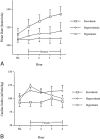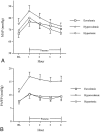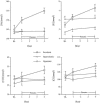Effect of intravascular volume expansion on renal function during prolonged CO2 pneumoperitoneum
- PMID: 10674610
- PMCID: PMC1420986
- DOI: 10.1097/00000658-200002000-00007
Effect of intravascular volume expansion on renal function during prolonged CO2 pneumoperitoneum
Abstract
Objective: To evaluate whether intravascular volume expansion would improve renal blood flow and function during prolonged CO2 pneumoperitoneum.
Summary background data: Although laparoscopic living donor nephrectomies have a considerably reduced risk of complications for the donors, significant concerns exist regarding procurement of a kidney in the altered physiologic environment of CO2 pneumoperitoneum. Recent studies have documented adverse effects of CO2 pneumoperitoneum on renal hemodynamics.
Methods: Renal and systemic hemodynamics and renal histology were studied in a porcine CO2 pneumoperitoneum model. After placement of a pulmonary artery catheter, carotid arterial line, Foley catheter, and renal artery ultrasonic flow probe, CO2 pneumoperitoneum (15 mmHg) was maintained for 4 hours. Pigs were randomized into three intravascular fluid protocol groups: euvolemic (3 mLkg/hour isotonic crystalloid), hypervolemic (15 mL/kg/hour isotonic crystalloid), or hypertonic (3 mL/kg/hour isotonic crystalloid plus 1.2 mL/kg/hour 7.5% NaCl).
Results: In the euvolemic group, prolonged CO2 pneumoperitoneum caused decreased renal blood flow, oliguria, and impaired creatinine clearance. Both isotonic and hypertonic volume expansions reversed the changes in renal blood flow and urine output, but impaired creatinine clearance persisted.
Conclusions: Intravascular volume expansion alleviates the effects of CO2 pneumoperitoneum on renal hemodynamics in a porcine model. Hypertonic saline (7.5% NaCl) solution may maximize renal blood flow in prolonged pneumoperitoneum, but it does not completely prevent renal dysfunction in this setting. This study suggests that routine intraoperative volume expansion is important during laparoscopic live donor nephrectomy.
Figures





References
-
- Shaffer D, Sahyoun AI, Madras PN, Monaco AP. Two hundred one consecutive living-donor nephrectomies. Arch Surg 1998; 133:426–431. - PubMed
-
- 1996 Annual Report of the U.S. Scientific Registry of Transplant Recipients and the Organ Procurement and Transplant Data, 1988–1995. UNOS, Richmond, VA, and the Division of Transplantation, Bureau of Health Resources and Services Administration, U.S. Department of Health and Human Services, Rockville, MD, 1996.
-
- Ratner LE, Kavoussi LR, Sroka M, et al. Laparoscopic assisted live donor nephrectomy—a comparison with the open approach. Transplantation 1997; 63:229–233. - PubMed
-
- Nogueira JM, Cangro C, Fink J, et al. Open versus laparoscopic donor nephrectomy: is there a difference in recipient renal function? [Abstract] Transplantation 1998; 65:185.
Publication types
MeSH terms
Substances
LinkOut - more resources
Full Text Sources
Other Literature Sources

